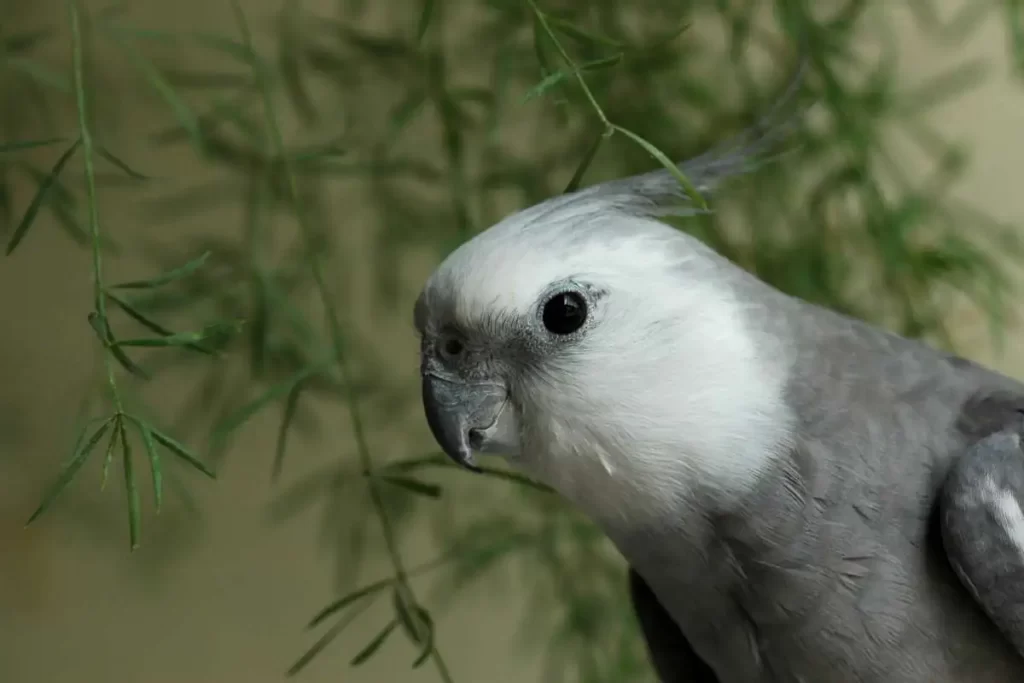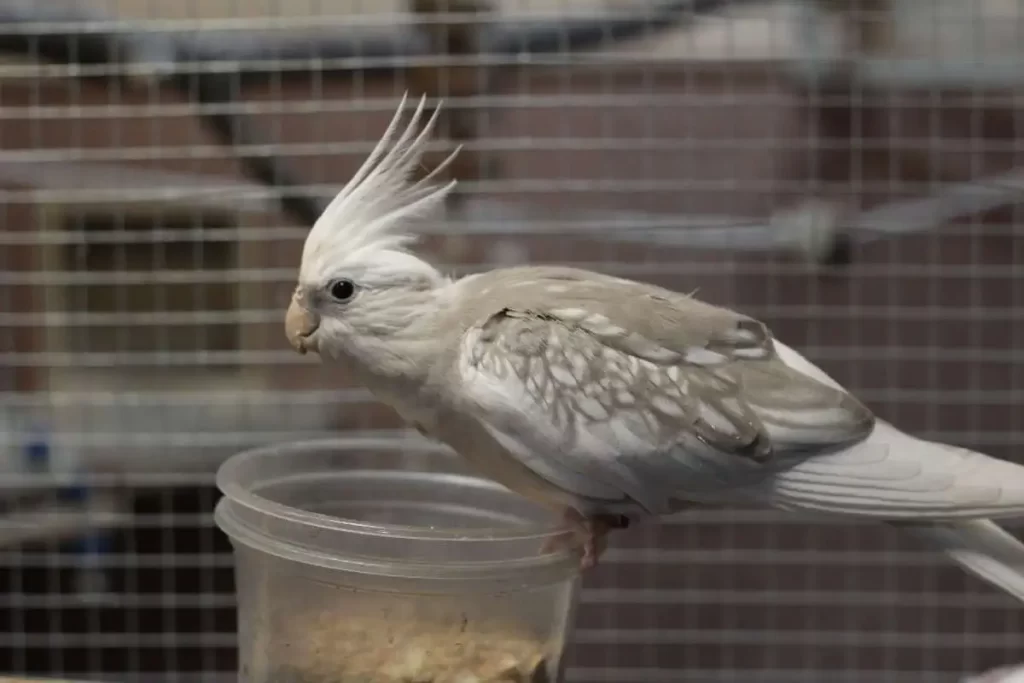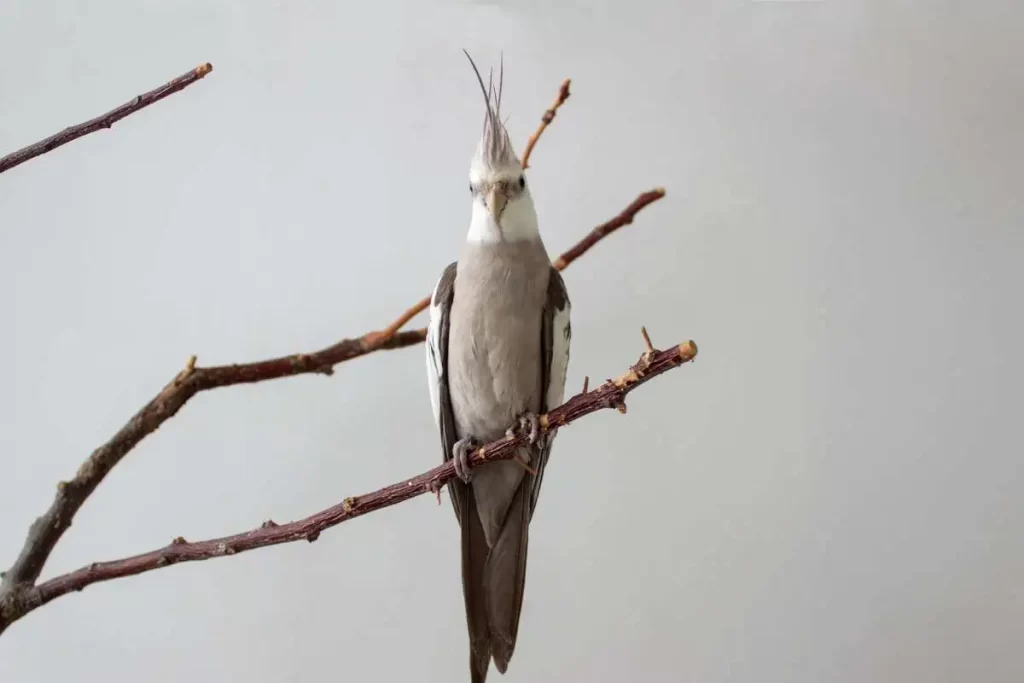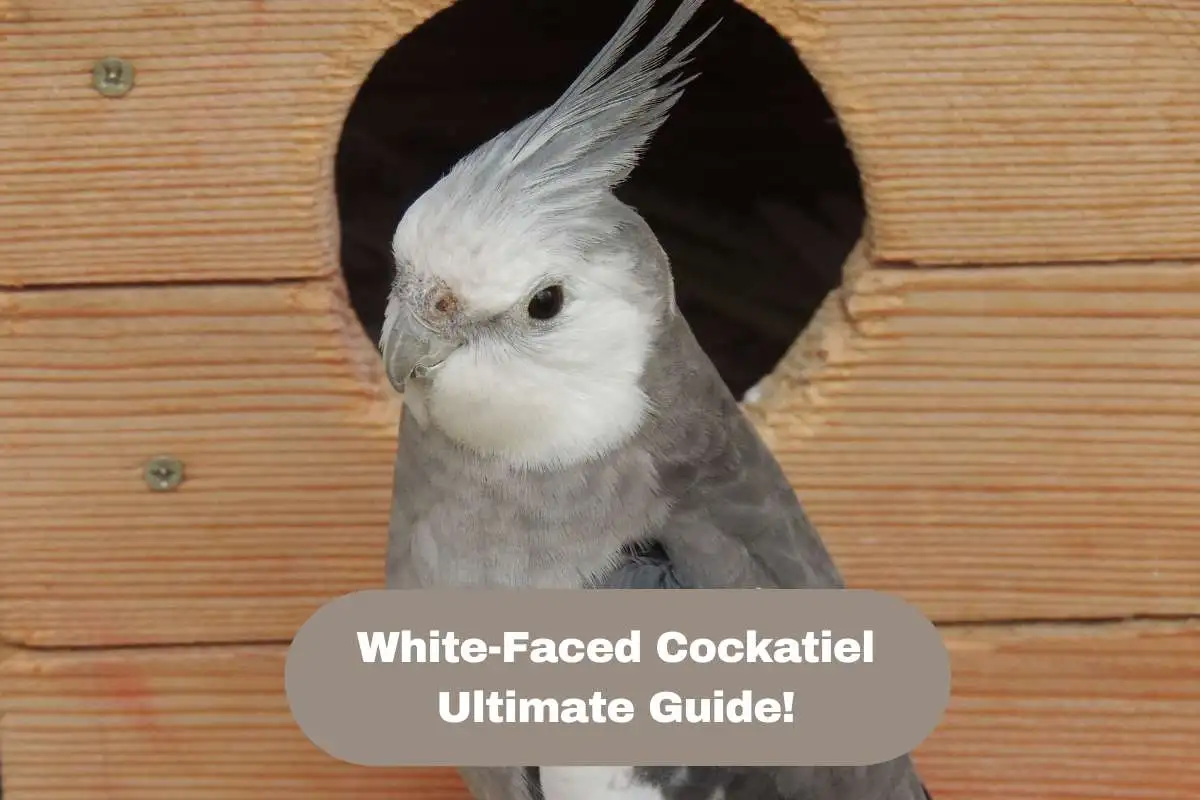A white-faced cockatiel is a type of parrot native to Australia and is a subspecies of the larger cockatiel species (Nymphicus hollandicus). White-faced cockatiels are known for their playful and social personalities and are popular pets due to their ability to mimic sounds and words.
They are found in various habitats, including woodlands, grasslands, and open savannas. White-faced cockatiels have been kept as pets for centuries and have become popular in many countries worldwide.
They are also known for their striking appearance, which includes a distinctive white face and crest and a range of color variations on their body, including grey, yellow, and orange. They can live for several years with proper care and nutrition. The average lifespan of a white-faced cockatiel is around 15-20 years, but some individuals have been known to live even longer.
In this article I have explain every aspect of this bird, so read on to keep learning more about it.
Physical Characteristics of White-Faced Cockatiels
| Physical Characteristic | Description |
| Size | Small to medium, typically 12 inches in length |
| Weight | 3-4 ounces |
| Color | Grey body with white face and crest, yellow and orange markings on wings and tail |
| Beak | Strong and curved, used for eating and climbing |
| Feet | Two toes pointing forward and two toes pointing backward, used for grasping and climbing |
| Wings | Used for flying and balancing while climbing |
| Tail | Long and narrow, used for balance and steering while flying |
| Crest | Located on top of the head, used for communication and displays of emotion |
Personality and Behavior of White-Faced Cockatiels
| Personality Trait | Description |
| Playful | Enjoys playing with toys and interacting with their owners |
| Social | Likes to be around people and other birds and may become lonely if left alone for long periods of time |
| Curious | Likes to explore and may be prone to getting into mischief |
| Independent | Can be trained and tamed, but may also be content to spend time on their own |
| Vocal | Known for their ability to mimic sounds and words, but may also make a variety of other sounds |
| Affectionate | Can bond closely with their owners and may enjoy being petted and cuddled |
| Territorial | May become possessive of their food, toys, or territory and may exhibit aggressive behavior towards other birds or animals |
How to Identify a White-Faced Cockatiel?

To identify a white-faced cockatiel, look for the following characteristics:
- Size: Are small to medium-sized birds, typically measuring around 12 inches in length.
- Color: They have a grey body with a white face and crest and may have yellow and orange markings on their wings and tail.
- Beak: They have a strong curved beak used for eating and climbing.
- Feet: White-faced cockatiels have two toes pointing forward and two toes pointing backward, which are used for grasping and climbing.
- Wings: White-faced cockatiels have wings used for flying and balancing while climbing.
White-Faced Cockatiel as a Pet
White-faced cockatiels are popular pets due to their playful and social personalities and ability to mimic sounds and words.
They are relatively easy to care for and are suitable for first-time bird owners (white face cockatiel is comparatively rare compared to lutino cockatiel). White-faced cockatiels require a spacious and well-ventilated enclosure, a varied and nutritious diet, and regular socialization and training to thrive.
They can bond closely with their owners and may enjoy being petted and cuddled. It is important to be aware that white-faced cockatiels can be prone to certain health issues and may require regular veterinary care.
Feeding and Nutrition

A balanced and nutritious diet is essential for the health and well-being of white-faced cockatiels. A good diet for a white-faced cockatiel should include a mix of seeds, fresh fruits and vegetables, and high-quality pellet food.
It is important to choose a seed mix formulated specifically for parrots and to supplement the diet with various fresh foods to provide a complete and balanced nutrition profile.
It is also important to provide clean, fresh water and avoid giving your white-faced cockatiel foods that are toxic or unhealthy, such as avocados, chocolate, and onions.
Housing and Enclosure
This bird require a spacious and well-ventilated enclosure with plenty of room to move around and climb.
A cage that measures at least 24 inches by 18 inches by 18 inches is a good minimum size for a single white-faced cockatiel. It is important to provide your white-faced cockatiel with plenty of perches and climbing toys to keep them active and entertained.
It is also important to keep the cage clean and to provide fresh bedding and a clean water dish daily.
Health and Wellness
Maintaining the health and wellness of your white-faced cockatiel is important for their overall well-being. Some things you can do to keep your white-faced cockatiel healthy include:
- Provide a balanced and nutritious diet: A good diet for a white-faced cockatiel should include a mix of seeds, fresh fruits and vegetables, and a portion of high-quality pellet food.
- Keep the cage clean: Clean the cage and change the bedding and water dishes regularly to prevent the buildup of bacteria and parasites.
- Provide plenty of exercises: White-faced cockatiels need plenty of opportunities to move around and exercise to maintain their physical and mental health.
- Monitor your white-faced cockatiel’s behavior: Be aware of any changes in your white-faced cockatiel’s behavior or appearance that may indicate a health issue.
- Regularly visit the veterinarian: It is important to take your white-faced cockatiel to the veterinarian regularly for check-ups and to address any health concerns.
Grooming and Hygiene
Proper grooming and hygiene are important for the health and well-being of white-faced cockatiels. Some things you can do to keep your white-faced cockatiel well-groomed include:
- Trim your white-faced cockatiel’s beak and nails regularly: The beaks and nails of this bird naturally grow over time and may need to be trimmed to keep them at a healthy length. It is important to use the appropriate tools and to be gentle when trimming your white-faced cockatiel’s beak and nails.
- Bathe your white-faced cockatiel: White-faced cockatiels enjoy taking baths, which is a good way to keep their feathers clean and healthy. You can offer your white-faced cockatiel a shallow dish of water or mist its feathers with a spray bottle of water.
- Keep your white-faced cockatiel’s cage clean: Clean the cage and change the bedding and water dishes regularly to prevent the buildup of bacteria and parasites.
- Protect your white-faced cockatiel’s skin and feathers: They have sensitive skin and feathers, and protecting them from extreme temperatures and harsh chemicals is important.
Training and Socialization for White-Faced Cockatiels
Training and socialization are important for white-faced cockatiels’ well-being and can help strengthen the bond between you and your bird. Some things you can do to train and socialize your white-faced cockatiel include:
- Start training early: It is easier to train a white-faced cockatiel when they are young, but there is always time to start.
- Use positive reinforcement: Reward your white-faced cockatiel with treats and praise when they exhibit the desired behaviour.
- Be patient and consistent: Training and socialization can take time, and your approach must be patient and consistent.
- Provide plenty of socialization opportunities: White-faced cockatiels are social animals, and it is important to provide them with plenty of opportunities to interact with people and other birds.
- Enrol in a training class: Consider enrolling in a training class or working with a professional bird trainer to learn more about how to train and socialize your white-faced cockatiel.
Common Health Problems in White-Faced Cockatiels
Like all pets, white-faced cockatiels are susceptible to certain health problems. Some common health problems that can affect white-faced cockatiels include:
- Malnutrition: White faced cockatiels require a balanced and nutritious diet to maintain their health. A diet that is low in nutrients or unbalanced can lead to malnutrition and a range of health problems.
- Feather picking: White-faced cockatiels may pick at their feathers due to boredom, stress, or a dietary deficiency. This can lead to bald patches and affect the bird’s overall health and appearance.
- Respiratory infections: White-faced cockatiels are prone to respiratory infections, which various factors, including a dirty environment, stress, or a weak immune system, can cause.
- Psittacosis: Psittacosis, also known as parrot fever, is a bacterial infection that can affect white-faced cockatiels and other parrots. It is transmitted through the respiratory system and can be serious if left untreated.
- Feather lice and mites: White-faced cockatiels may be prone to infestations of feather lice and mites, which can cause itching, irritation, and feather damage.
Reproduction and Breeding

White-faced cockatiels can reproduce and breed in captivity with the proper care and conditions. White-faced cockatiels are sexually dimorphic, which means that males and females can be distinguished by their physical appearance.
Males have a more brightly coloured head and crest, while females have a more subdued head and crest. White-faced cockatiels typically reach sexual maturity at around 1-2 years of age.
To breed white-faced cockatiels, you will need to provide them with a suitable breeding environment, including a spacious and well-ventilated enclosure, a nest box, and a variety of toys and perches.
It is important to provide the birds with a nutritious diet and to monitor their health and behaviour during the breeding process. White-faced cockatiels typically lay clutches of 2-5 eggs, and both parents participate in incubating the eggs and raising the chicks.
It is important to be aware that breeding white-faced cockatiels requires a significant time and financial commitment and is not suitable for everyone. It is important to research and seek guidance from a veterinarian or an experienced breeder before attempting to breed white-faced cockatiels.
White-Faced Cockatiel Mutations and Hybridization
White-faced cockatiels can exhibit a range of colour mutations due to genetic variations. Some common white-faced cockatiel mutations include:
- Lutino: Lutino white-faced cockatiels have a yellow body and a white face and crest.
- Pearl: Pearl white-faced cockatiels have a grey body with small white dots, or “pearls,” on their wings and tail.
- Cinnamon: Cinnamon white-faced cockatiels have a reddish-brown body with a white face and crest.
- Pied: Pied white-faced cockatiels have a white body with irregular patches of grey or yellow.
In addition to these mutations, white-faced cockatiels can also be hybridized with other parrot species to create new colour variations. It is important to be aware that hybridization can negatively affect the health and well-being of the birds and is not recommended.
Colors and Patterns
White-faced cockatiels can come in various colors and patterns due to genetic variations. The most common color for white-faced cockatiels is grey, with a white face and crest and yellow and orange markings on the wings and tail.
However, white-faced cockatiels can also exhibit a range of color mutations and patterns due to genetic variations, including lutino (yellow), pearl (grey with white dots), cinnamon (reddish-brown), and pied (white with irregular patches of grey or yellow).
It is important to be aware that hybridization with other parrot species can also create new color variations, but this is not recommended due to the potential negative effects on the health and well-being of the birds.
Singing and Mimicry
White-faced cockatiels are known for their ability to mimic sounds and words and are often referred to as “little comedians” due to their playful and vocal personalities.
White-faced cockatiels can learn to mimic various sounds and may even learn to whistle tunes or mimic the sounds of other animals. In addition to mimicry, white-faced cockatiels are also known for their singing abilities and may produce a variety of vocalizations, including whistles, chirps, and clicks.
White-faced cockatiels can learn to mimic and sing through exposure to different sounds and with the help of their owners. It is important to be patient and to reward your white-faced cockatiel with treats and praise when they mimic or sing.
It is also important to be aware that white-faced cockatiels may be more prone to mimicry and singing if kept in a stimulating and social environment.
Behavior and Communication
White-faced cockatiels are social and playful birds known for their unique behaviour and communication styles. Some common behaviours and communication techniques used by white-faced cockatiels include:
- Body language: White-faced cockatiels use a variety of body language cues to communicate their mood and intentions, including puffing up their feathers, spreading their wings, and tilting their head.
- Vocalizations: White-faced cockatiels can produce a variety of vocalizations, including whistles, chirps, and clicks, to communicate with their owners and other birds.
- Mimicry: White-faced cockatiels are known for their ability to mimic sounds and words and may learn to imitate various sounds and words with the help of their owners.
- Playfulness: White-faced cockatiels are playful and enjoy playing with toys and interacting with their owners.
Toys and Enrichment
White-faced cockatiels are intelligent and curious birds that require a variety of toys and enrichment activities to keep them mentally and physically stimulated. Some ideas for toys and enrichment activities for white-faced cockatiels include:
- Chew toys: White-faced cockatiels have strong beaks and enjoy chewing on toys, such as wood blocks, rope toys, and paper products.
- Foraging toys: White-faced cockatiels enjoy searching for and finding food, and foraging toys can help to stimulate their natural foraging behaviour.
- Climbing toys: White-faced cockatiels are natural climbers and enjoy toys that allow them to climb and perch, such as ladders and swings.
- Social interaction: White-faced cockatiels are social animals and enjoy interacting with their owners and other birds. Providing your white-faced cockatiel with plenty of socialization opportunities can help to keep them happy and engaged.
White-Faced Cockatiel Cages and Enclosures
White-faced cockatiels require a spacious and well-ventilated enclosure to live in. A good minimum size for a cage for a single white-faced cockatiel is 24 inches by 18 inches by 18 inches, although a larger cage is always better.
It is important to provide your white-faced cockatiel with plenty of perches and climbing toys to keep them active and entertained and to keep the cage clean and well-maintained.
It is also important to provide your white-faced cockatiel with plenty of opportunities to fly and exercise outside of the cage to maintain their physical and mental health. By providing your white-faced cockatiel with a suitable and well-maintained enclosure, you can help to ensure their overall well-being.

